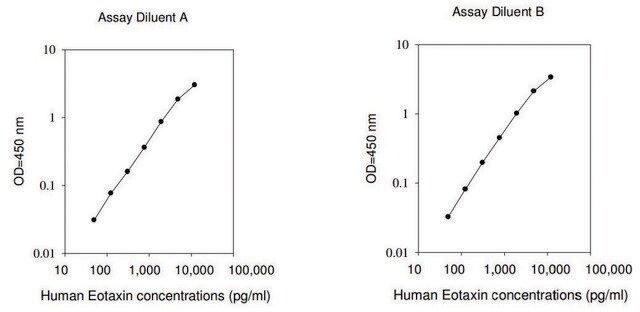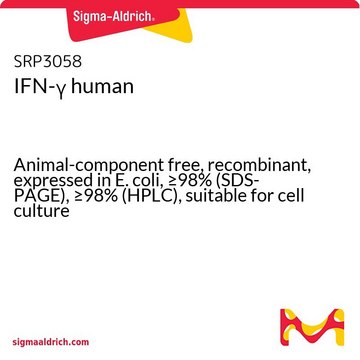推荐产品
生物源
human
品質等級
重組細胞
expressed in E. coli
化驗
>97% (SDS-PAGE)
形狀
lyophilized powder
效力
0.25-1.0 mg
分子量
~8.2 kDa
包裝
pkg of 25 μg
儲存條件
avoid repeated freeze/thaw cycles
技術
cell culture | mammalian: suitable
雜質
endotoxin, tested
UniProt登錄號
儲存溫度
−20°C
基因資訊
human ... CCL26(10344)
相关类别
一般說明
Eotaxin-3, also known as CCL26 or SCYA26, is a human CC chemokine and a functional ligand for CC chemokine receptor 3. This gene is localized to human chromosome 7q11.2, which codes for a protein of 71 amino acids. It belongs to the small inducible cytokine subfamily A , which also includes eotaxin and eotaxin-2.
生化/生理作用
Eotaxin-3 is a potent attractant of eosinophils, and might be responsible for the accumulation of eosinophils in atopic diseases. As it is involved in the recruitment of eosinophils in inflammatory diseases, it, along with its receptor, might have potential as therapeutic target in inflammatory disorders, such as asthma. Demethylation results in increased expression of this gene, which in turn influences allergic reactions. This gene is overexpressed in bullous pemphigoid (BP), which results in the accumulation of eosinophils in skin lesions, thus, contributing to the pathogenesis of BP. Its expression is also elevated in the active lesions of patients with ulcerative colitis (UC) and Crohn′s disease (CD). Thus, it might play a role in the pathogenesis of UC, where its major source is colonic myofibroblasts.
Eotaxin-3, also known as CCL26 or SCYA26, is a human CC chemokine and a functional ligand for CC chemokine receptor 3. Mature recombinant human eotaxin-3 has a molecular mass of approximately 8.2 kDa and demonstrates chemotactic activity for eosinophils.
外觀
Lyophilized from a 0.2 μm filtered solution in 30% acetonitrile and 0.1% trifluoroacetic acid containing 1.25 mg bovine serum albumin.
分析報告
The biological activity is measured by its ability to induce chemotaxis of rat Y3 cells stably expressing hCCR3.
訊號詞
Warning
危險聲明
危險分類
Acute Tox. 4 Inhalation - Eye Irrit. 2
儲存類別代碼
11 - Combustible Solids
水污染物質分類(WGK)
WGK 2
閃點(°F)
Not applicable
閃點(°C)
Not applicable
Eunjin Lim et al.
Journal of immunology (Baltimore, Md. : 1950), 192(1), 466-474 (2013-12-11)
DNA demethylation has been primarily studied in the context of development biology, cell fate, and cancer, with less attention on inflammation. In this article, we investigate the association between DNA methylation and production of the chemoattractant cytokine eotaxin-3 in the
M Kitaura et al.
The Journal of biological chemistry, 274(39), 27975-27980 (1999-09-17)
Previously, we mapped the novel CC chemokine myeloid progenitor inhibitory factor 2 (MPIF-2)/eotaxin-2 to chromosome 7q11.23 (Nomiyama, H., Osborne, L. R., Imai, T., Kusuda, J., Miura, R., Tsui, L.-C., and Yoshie, O. (1998) Genomics 49, 339-340). Since chemokine genes tend
C Günther et al.
Clinical and experimental immunology, 166(2), 145-153 (2011-10-12)
Eosinophils contribute to the pathogenesis of bullous pemphigoid (BP) by secretion of proinflammatory cytokines and proteases. Trafficking of eosinophils into tissue in animal models and asthma depends on interleukin-5 and a family of chemokines named eotaxins, comprising CCL11, CCL24 and
R F Guo et al.
Genomics, 58(3), 313-317 (1999-06-22)
By searching the Expressed Sequence Tag database, a full-length cDNA for a novel human CC chemokine was cloned. This cDNA encoded a 94-amino-acid protein with a putative signal peptide of 26 amino acids. The deduced mature protein had the four
A Shinkai et al.
Journal of immunology (Baltimore, Md. : 1950), 163(3), 1602-1610 (1999-07-22)
IL-4 has been shown to be involved in the accumulation of leukocytes, especially eosinophils, at sites of inflammation by acting on vascular endothelial cells. To identify novel molecules involved in the IL-4-dependent eosinophil extravasation, cDNA prepared from HUVEC stimulated with
我们的科学家团队拥有各种研究领域经验,包括生命科学、材料科学、化学合成、色谱、分析及许多其他领域.
联系技术服务部门








